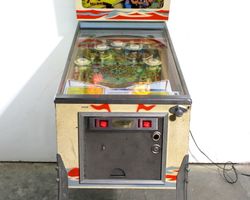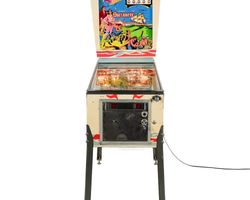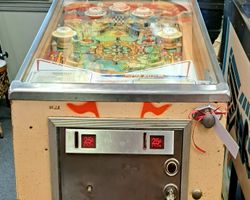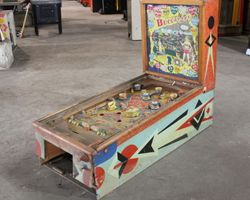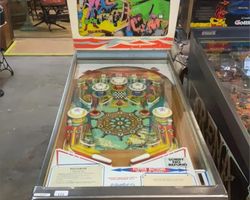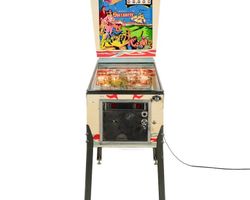Buccaneer
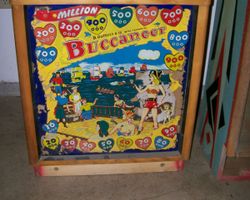
Average Prices: USD $400 to $1,000
Produced: October, 1948
Production Run: 3,650 units
Machine Type: Electro-mechanical
Players: 1
Design by: Harry Mabs
Art by: Roy Parker
The D. Gottlieb & Co. machine, "Buccaneer," launched in October 1948, represents a significant point in pinball history, arriving at a time when the flipper mechanism, patented just two years prior, was rapidly transforming game design. As Model Number 11 from Gottlieb, this electro-mechanical (EM) game carved out its niche with a captivating pirate theme, brought to life through the collaborative efforts of designer Harry Mabs and artist Roy Parker. Mabs, credited with the game's design, concept, animation, and mechanics, was a prolific figure in Gottlieb's early years, instrumental in shaping the play experiences of the era. Roy Parker, on the other hand, was celebrated for his ability to translate themes into vivid, eye-catching backglass and playfield art. "Buccaneer" emerged into a market eager for new gameplay innovations, positioning itself as a one-player experience that built upon the newfound possibilities offered by player-controlled flippers. While production figures for this specific 1948 "Buccaneer" are not available, its existence solidified Gottlieb's commitment to advancing pinball technology and thematic richness, standing distinct from a later solid-state game of the same name released by Gottlieb in 1976.
Signature Features and Design
"Buccaneer" stands out primarily for its pioneering use of four flippers, a notable advancement for a 1948 title. At a time when many games were still experimenting with single or dual flipper layouts, the inclusion of four offered players unprecedented control and introduced new strategic possibilities to the gameplay. These flippers, paired with eight passive bumpers, provided a dynamic playfield where the ball could ricochet unpredictably, yet still be influenced by player input. The game also featured three kick-out holes, serving as key targets for players aiming for specific objectives or high scores.
Roy Parker's artistic contribution is a defining element of "Buccaneer." The pirate theme permeates the machine, from the detailed backglass depicting swashbuckling adventures on the high seas to the playfield artwork adorned with treasure chests, shipwrecks, and marauding buccaneers. Parker's style, characterized by bold lines and a vibrant color palette, effectively transported players into a world of maritime peril and buried riches. The simple yet effective sound design, comprising two bells and a knocker, provided satisfying auditory feedback for points scored, targets hit, and special achievements, reinforcing the classic electro-mechanical charm of the era. A unique "time clock" feature added an intriguing layer to the game, hinting at objectives or scoring mechanisms tied to a temporal element, though its precise function varied across early EM designs. The machine's cabinet design remained true to the standard upright format of the period, allowing the focus to remain on the engaging playfield and evocative backglass display.
Playfield and Mechanics
The "Buccaneer" playfield layout is a testament to Harry Mabs' design ingenuity within the constraints of late 1940s pinball technology. The presence of four flippers immediately suggests a design philosophy that encouraged more precise shot-making rather than relying solely on the chaotic bounce of earlier games. While the exact positioning of all four flippers might vary slightly, typically, two would be located at the bottom for primary ball control, with others strategically placed higher up to allow for shots to upper playfield elements or to save the ball from draining.
The eight passive bumpers, strategically scattered across the playfield, ensured that even un-flippered shots contributed to the score and kept the ball in active play. These bumpers, essentially fixed posts, would send the ball careening in new directions upon impact, creating unpredictable trajectories that demanded quick reflexes from the player. The three kick-out holes were central to the playfield's objectives, likely offering higher point values, activating special features, or granting extra balls upon successful entry. Lining up shots to these holes became a primary strategic goal, leveraging the newly available flipper control.
Aesthetically, the playfield was a rich canvas for Roy Parker's pirate theme. Detailed illustrations of ships, islands, and treasure maps guided the player's eye and immersed them in the narrative. The lighting, though rudimentary by modern standards, effectively highlighted scoring areas and activated features, adding visual excitement to the mechanical action. The overall design balanced open spaces for ball movement with clusters of targets and features, creating a playfield that was both visually appealing and mechanically engaging for its time. The integration of mechanical elements, such as score reels and relays, beneath the playfield created the distinctive hums and clicks characteristic of EM machines, contributing to the visceral experience of playing "Buccaneer."
Gameplay Dynamics
Gameplay in "Buccaneer" revolved around a straightforward yet compelling scoring system, typical of electro-mechanical machines of the late 1940s. Players accumulated points by hitting the numerous passive bumpers, which offered immediate, albeit lower, score increments. The true scoring opportunities, however, lay in successfully aiming for and sinking the ball into the three kick-out holes. These holes likely awarded significant points, potentially triggering bonus multipliers, lighting up special features, or granting extra balls, thereby encouraging players to hone their flipper skills.
The "time clock" feature, while details on its exact implementation remain open to interpretation, likely presented a unique challenge or scoring opportunity. It could have been a timed bonus, where scoring within a certain window yielded higher points, or a progressive element that advanced as certain targets were hit, culminating in a special award. This early form of a timed objective added a layer of urgency and strategic depth, distinguishing "Buccaneer" from more purely score-accumulation-based games.
Player strategy in "Buccaneer" involved a delicate balance of control and opportunism. With four flippers, players had multiple points of control, allowing for more intricate shots and saves. Mastering the timing and power of each flipper was crucial for directing the ball towards the high-value kick-out holes or for keeping it in play amidst the barrage of bumper deflections. The gameplay was a continuous cycle of launching the ball, skillfully nudging and flipping to navigate the pirate-themed playfield, aiming for specific targets, and reacting to the unpredictable bounces. The objective was not just to keep the ball alive but to strategically funnel it towards the most rewarding paths, aiming to activate special features or achieve the highest score before the ball drained, solidifying its place as an early example of the evolving art of pinball design.
Reception and Legacy
"Buccaneer" by Gottlieb, despite its age and the passage of nearly eight decades, holds a distinct place within the pinball community, particularly among enthusiasts of electro-mechanical machines. Its primary strength lies in its historical significance as an early adopter of the four-flipper configuration, pushing the boundaries of what was possible in pinball design shortly after the flipper's invention. This innovation provided a level of player control and strategic depth that was advanced for its time, moving away from the more chaotic, luck-based games that preceded it. The immersive pirate theme, beautifully rendered by Roy Parker's artwork, also stands as a significant draw, demonstrating how thematic integration could elevate the player experience even with simpler mechanics. The collaborative expertise of Harry Mabs in design and mechanics, combined with Parker's artistry, created a cohesive and engaging package that resonated with players of the late 1940s.
However, like all machines of its era, "Buccaneer" exhibits inherent limitations when viewed through a contemporary lens. Its gameplay, while innovative for 1948, is simpler compared to later EM games and certainly modern solid-state machines. Modes are rudimentary, and scoring often relies on repetitive target hitting rather than complex rule sets or multi-ball play. The sounds are limited to bells and a knocker, lacking the rich audio landscapes of later machines. Despite these inherent characteristics of early EM design, feedback from collectors and historians often highlights its charm and foundational importance.
The machine's legacy is primarily centered on its contribution to the evolution of flipper-based gameplay. "Buccaneer" was part of the wave of games that cemented the flipper as the central interactive mechanism in pinball, demonstrating how multiple flippers could open up new avenues for playfield design and shot opportunities. It served as a stepping stone, influencing subsequent designs that would further refine flipper placement, target arrays, and scoring complexities. While not as widely known as some later Gottlieb classics, "Buccaneer" is recognized as an important artifact for understanding the foundational period of modern pinball. Its pirate theme, a perennial favorite in pinball, also showcased the power of strong visual storytelling to draw players in, setting a precedent for many themed games that would follow in the decades to come. As such, it remains a machine valued for its historical context and its role in shaping the trajectory of pinball's mechanical and artistic development.
Sponsored Links
 Ebay Listings
Ebay Listings
 Auction Results
Auction Results
| Cost | Location | Date |
|---|---|---|
| USD $800 |  Pennsylvania, United States Pennsylvania, United States |
01 September, 2024 |
| CAD $775 |  Canada Canada |
28 August, 2024 |
| USD $1,100 |  Georgia, United States Georgia, United States |
15 June, 2024 |
| USD $650 |  Illinois, United States Illinois, United States |
21 April, 2024 |
| USD $650 |  Illinois, United States Illinois, United States |
18 April, 2024 |
| USD $600 |  Maryland, United States Maryland, United States |
07 September, 2023 |
| AUD $1,200 |  Victoria, Australia Victoria, Australia |
17 October, 2021 |
| AUD $2,200 |  Victoria, Australia Victoria, Australia |
26 September, 2021 |
| USD $125 |  Maryland, United States Maryland, United States |
29 April, 2021 |
| USD $599 |  United States United States |
16 December, 2019 |


Private Policy · Search Website · Contact Us
As an eBay Partner, we may earn a commission from qualifying purchases made through links on this site, at no additional cost to you.
All trademarks and copyrighted materials remain property of their respective owners. All other content copyright 2007 - 2025 Pinpedia.

